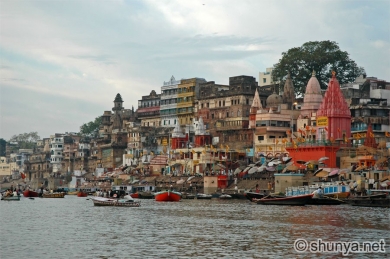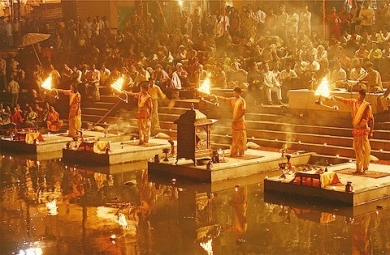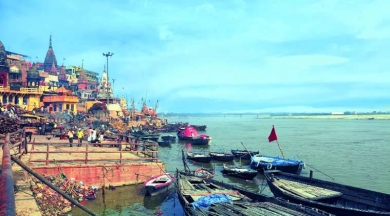Varanasi is one of the oldest living cities in the world. Many names have been given to Varanasi, though its recently revived official appellation is mentioned in the Mahabharata and in the Jataka tales of Buddhism. It probably derives from the two rivers that flank the city, the Varuna to the north and the Asi to the south.. Many still use the anglicized forms of Banaras or Benares, while pilgrims refer to Kashi, first used three thousand years ago to describe the kingdom and the city outside which the Buddha preached his first sermon; the "City of Light" is also called Kashika, "the shining one", referring to the light of Shiva. Another epithet, Avimukta, meaning "Never Forsaken", refers to the city that Shiva never deserted, or that one should never leave. Further alternatives include Anandavana, the "forest of bliss", and Rudravasa, the place where Shiva (Rudra) resides.
Varanasi’s associations with Shiva extend to the beginning of time: legends relate how, after his marriage to Parvati, Shiva left his Himalyan abode and came to reside in Kashi with all the gods in attendance. Temporarily banished during the rule of the great king Divodasa, Shiva sent Brahma and Vishnu as his emissaries, but ultimately returned to his rightful abode protected by his loyal attendants Kalabhairav and Dandapani. Over 350 gods and goddesses, including a protective ring of Ganeshaa form a mandala or sacred pattern with Shiva Vishwanatha at its centre.
Most important places to Visit in Varanasi. / Sightseeing places in Varanasi.
Which all places I can visit along with Varanasi?
Tour Itineries along with Varanasi.
Best time to visit Varanasi.
How to reach Varanasi?
Most important places to Visit in Varanasi. / Sightseeing places in Varanasi.
Vishwanath temple (Golden Temple)
The most sacred temple in Varanasi is the Vishwanath temple, located at VishvanathGali dedicated to Lord Shiva. Hindus believe Shiva lives here, so it's far too holy a place for non-Hindus to view, the followers of other religions are permitted a view from the NaubatKhana (seat of temple choir). The shivalinga at the Vishwanath temple is among one of the 12 Jyotrilingas.
The current temple was built in 1776 by AhalyaBai of Indore with about 800 kg of gold plating on the towers, which gives the temple its colloquial name, Golden Temple. The gold plated spire, was the gift of the Sikh Maharaja Ranjit Singh of Lahore in 1835, more than 50 years later. The well of wisdom or 'GyanVapi' which is nearby is believed to have been built by Lord Shiva himself to cool the 'linga' of Vishwanath with water.
Sarnath
The Buddha came to this hamlet, 10 Km. north-east of Varanasi, to preached his message "Maha-Dharma-Chakra Pravartan" (in Buddhist terminology, 'turned the wheel of the law') after he achieved enlightment at Bodhigaya. Later, the great Buddhist Emperor Ashoka built here the DharmarajikaStupa and near it erected a pillar surmounted by the magnificent capital of four adored lions, which today forms the national emblem of India. Ashoka erected several memorial towers or stupas.
Saranath probably derived its name from one of Buddha's title, Saranganath, Lord of the Deer. The Chinese Buddhist pilgrims, Fa-hsien and HiuenTsiang who visited in the 5th and 7th centuries respectively, both recorded impressions of their stay. The huge swastika (110ft) covered DhameskhStupa dates from AD 500 and is thought to mark the place where Buddha gave his sermon. Sarnath has been a premier centre for Buddhism. It is a rich collection of ancient Buddhist relics and antiques comprising numerous Buddha and Bodhisatva images on display at the excellent Archaeological Museum (open 10am to 5pm except on Friday).
Saranath's annual festival is Buddha Purnima, which commemorates Buddha's birth with colourful fair and procession of his relics held on the full moon of May/June.
Ramnagar
The residential place of KashiNaresh (Former Maharaja of Varanasi) across the Ganges at Ramnagar houses a museum with the exhibits of palanquins, costumes, swords, sabres, etc. Dussehra celebration of Ramnagar is an interesting event to witness.14 km. from Varanasi. The fort at Ramnagar houses a museum displaying the Royal collection which includes vintage cars, Royal palkies, an armoury of swords and old guns, ivory work and antique clock. The Durga Temple and Chhinnamastika Temple are also located at Ramnagar.Ramnagar Fort which was built in 1750A.D by the Maharaja of Banaras, is on the right bank of River Ganga. Built of red stones, it provides strength and stability to the city. Visit : Daily from 0900 t0 1200 and 1400 - 1500. It is the residential palace of the former Maharaja of Varanasi. The palace is an astronomical and astrological wonder. Inside the giant walls of the palace, there is a big clock. Besides showing year, month, week and day, it baffles the onlooker with astronomy of the sun, moon and constellation of stars. This wonder clock or DharamGhari was made by the court astronomer of Banaras in 1852A.D. The palace has a temple dedicated to VedVyas and a museum set up by the last Maharaja of Banaras, VibhutiNarain Singh. The museum has a collection of brocade costumes, palanquins, weapons and has expensive coaches made of ivory. The palace is decorated majestically and it vibrates with colour and life, during Dussehra festival. The celebrations comes to an end on Vijayadashmi, when the huge effigies of demon king Ravana and his kinsmen are sent up in flames, signifying the victory of good over evil.
Chunar Fort
The Chunar fort is situated 40 Km. from Varanasi. Chunar Fort, overlooking the Ganges, has had a succession of owners representing most of India's rulers over the last 500 years.Sher Shah took it from Humayun in 1540, Akbar recaptured it for the Mughals in 1575 and in the 18th century it passed to the nawabs of Avadh. They were shorty followed by the British, whose gravestones here make interesting reading. Chunar sandstone has been used for centuries, most famously in Ashokan pillars - and is still quarried, leaving the surrounding hills looking ravaged in places.
Durga Temple
It was built in the 18th century by a Bengali maharani and is stained red with ochre. The Durga Temple is commonly known as the Monkey Temple due to the many frisky monkeys that have made in their home. Non-Hindus can enter the courtyard but not the inner sanctum.
Kedareshvara Temple
It is the most important Shiva temple of the city. The stone linga here is said to have emerged spontaneously. The myth narrate that a pure hearted devotee of Shiva prayed for a chance to visit the famous Kedareshvara Shiva temple in the Himalayas.
Shiva, who is the god of destruction is always kind to his bhaktas (devotees). Shiva was touched by his bhakta's piety and instead of bringing him to the mountain, Shiva brought his image to the bhakta. This image (linga) emerged out of a plate of rice and lentils. It can be still seen by the believers on the rough surface of the natural stone linga.
ABC Art Gallery This gallery is situated opposite of TulsiManasMandir, DurgaKund Road. Opens from 1500 to 1900.Entry - free. This gallery exhibits the work of well known artists of India. It gives a picture of the contemporary culture of Varanasi.
Alamgir Mosque This mosque was constructed by Aurangazeb. It is a blend of Hindu and Muslim designs. A famous bathing point, PanjagangaGhat lies below it.
B.H.U. & Bharat Kala Bhavan Museum Banaras Hindu University (B.H.U) founded by PanditMadan Mohan Malviya in 1917A.D is the largest residential University in India. At the entrance, there is the grand statue of its founder and the Vishwanath temple in its centre. The huge temple was built in 1966, under patronage of the Birlas. It has a 677 meter high rising white top and its well carved architecture attracts pilgrims.
In the cool and calm surroundings of B.H.U is the Bharat Kala Bhavan which has established in 1920A.D and has a vast collection of paintings, Hindu and Buddhist sculptures and other materials of archeological studies. In the main hall of the Bhawan, there is a figure of a man standing on one leg and one hand on his hip and lifting a mass of stone above his head, with one hand. The figure is said to be of Lord Krishna lifting Govardana. In the halls of the Bharat Kala Bhawan, there are many rare images that testify to the existence of Krishna cult in Kashi in 15th and 16th century Gupta period. It has the miniature paintings from the courts of Mughals and the Hindu Princes of Punjab Hills. Visit : Monday to Saturday . Opens from 1030 to 1600.Entry - free.
SankatMochan Temple
It is at DurgaKund Road. The word SankatMochan means deliverer from troubles. The temple belongs to Hanuman (monkey God), an incarnation of Vishnu. The best time to visit this temple is in the early evening.
Gyanvapi Mosque
This mosque was built by Mughal emperor Aurangazeb. The foundation and the rear part of the mosque are the remains of a temple. One of its minarets which dominated the skyline of the holy city, collapsed in the1948 floods.
Shitala Temple
This white temple is dedicated to Shitala, the smallpox goddess. It is situated at ShitalaGhat. The Santoshi Mata (Mother of Contentment) shrine is added to this temple.
Chausath Yogini Temple
This temple is situated just above the Chausath Yogini Ghat. It was originally devoted to a tantric cult. Now it is devoted to Kali. The deity here is known as 'Ma' (mother).
Ashoka Pillar
It is at Saranath, 10km north of Varanasi. Sarnath, the place where Buddha gave his first sermon is a popular Buddhist pilgrimage centre. The Ashoka pillar stands in front of the main stupa where Ashoka sat and meditated. The Sarnath Archaeological Museum at AshokaMarg, houses a copy of Ashoka's lion pillar and some sculptures.
Which all places I can visit along with Varanasi?
Tour Itineries along with Varanasi.
Varanasi - Allahabad - Varanasi
Delhi - Varanasi - Sarnath
Delhi - Mathura - Agra- Allahabad - Varanasi
Delhi - Jaipur - Agra - Varanasi - Delhi
Delhi-Jaipur- Agra-Khajuraho-Varanasi- Bodhgaya-Rajgir-Nalanda- Patna-Delhi
Delhi – Varanasi – Allahabad – Ayodhya – Lucknow – Agra –Delhi – Haridwar – Rishikesh – Delhi
Delhi - Haridwar - Rishikesh - Varanasi -Agra - Mathura - Delhi
Delhi - Bodhgaya - Patna - Kushinagar - Lumbini - Sravasti - Varanasi - Delhi
Delhi - Varanasi -Bodhgaya - Patna -Kolkata - Bagdogara - Darjeeling - Pelling (Pemayangtse)- Gangtok - Kalimpong -Bagdogra – Delh
Delhi - Agra - Lucknow - Saravasti - Lumbini - Kushinagar - Patna - Bodhgaya - Varanasi – Delhi
How to reach Varanasi ?
How to reach Varanasi by Air
The nearest airport is Babatpur, 22 km from Varanasi and 30 Km from Sarnath. Direct flight for Varanasi are available from Delhi, Agra, Khajurao, Calcutta, Mumbai, Lucknow and Bhuvaneshwar airport.
How to reach Varanasi by Rail
Varanasi and Mughal Sarai (one of the main railway stations of Varanasi) are the important rail junctions, with train connections to all major cities of India. Some important trains are : RajdhaniExp ( Hawrah - Mughal Sarai - New Delhi); ToofanExp ( Howrah - Mughal Sarai - Delhi); North East Superfast Exp ( Delhi - Mughal Sarai Guwahati) ; MagadhExp ( Delhi - Mughal Sarai Patna) ; MahanagariExp ( Varanasi - Mumbai ) ; PawanExp ( Varanasi - Mumbai ) ; Sabarmati Exp ( Varanasi - Ahmedabad) ; Ganga KaveriExp ( Varanasi - Chennai) ; PoorwaExp ( Howrah - Varanasi - Delhi) HimgiriExp ( Jammu - Varanasi - Howrah ) ; SealdahExp ( Varanasi - Jammu Tawi).
How to reach Varanasi by Road
Varanasi, on NH 2 from Calcutta to Delhi, NHZ to KanyaKumari and NH 29 to Gorakhpur is well connected to the rest of the country by good motorable roads. some of the major road distances are : Agra - 565 km, Allahabad - 128 km, Bhopal - 791 km, Bodhgaya - 240 km, Kanpur - 330 km, Khajuraho - 405 km, Lucknow - 286, Patna - 246 km, Sarnath - 10 Km.
Best time to visit Varanasi
Varanasi is situated in the northern belt of India and hence experiences extreme climate conditions. With extremely hot and humid summer and monsoons to very cold winters, Varanasi is a place where climate is not really a deterrent. However, keeping the hot subtropical climate in mind, the best time to travel to Varanasi is during winters from October to March. Even though the temperatures drop drastically, the coolness in the air and the comfort with which one can move in this weather is not the same during summer season. The onset of winter is the best time to visit Varanasi for a dip in the holy Ganges when the temperature is cool but not cold. This is the best time to enjoy moving around the temples of Varanasi and revelling in its picturesque and beautiful environment
Packages

3 Nights Uttarpradesh - 3 Star - Rs.22900
Varanasi Packages
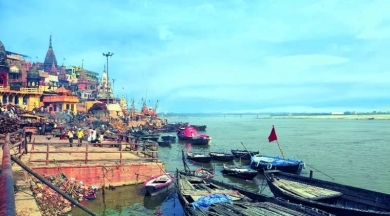
2 Nights Uttarpradesh - 3 Star - Rs.11200 - For 2 Adults
Varanasi Packages
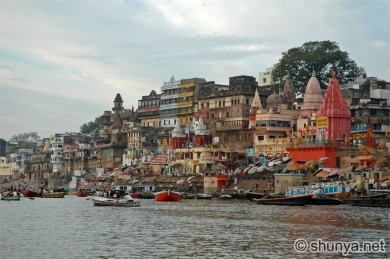
4 Nights Uttarpradesh - 3 Star - Rs.26400 - For 2 Adults
Varanasi Packages
